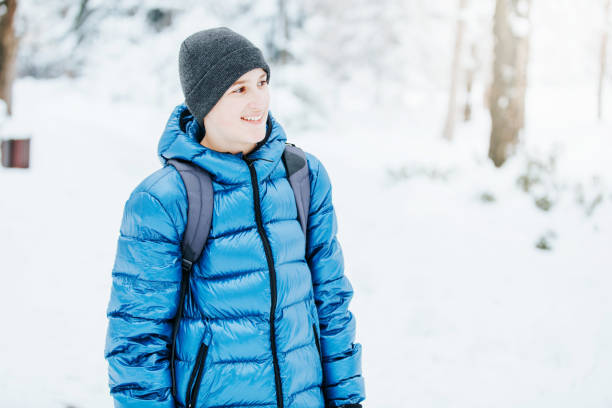Boys’ winter clothes do require special care to maintain their quality and durability. Proper washing and storage techniques can prolong their lifespan.
Winter clothes for boys often face harsh conditions, making proper care essential. Fabrics like wool, fleece, and synthetic materials need specific washing instructions to prevent damage. Regular maintenance, like removing stains promptly and avoiding high heat in the dryer, keeps garments looking fresh.
Seasonal changes also call for smart storage solutions to keep clothes in top shape. Investing time in proper care ensures these clothes remain functional and stylish throughout the winter months. Understanding fabric types and care labels helps parents make informed decisions, ensuring their boys stay warm and comfortable while enjoying winter activities.
Table of Contents
Seasonal Challenges For Boys’ Winter Wear
Boys’ winter clothes face unique challenges each year. Cold weather impacts fabric quality and durability. Understanding these challenges helps in choosing the right clothing.
Impact Of Cold Weather On Fabrics
Cold weather affects various fabrics used in boys’ winter wear. Here are some common effects:
- Shrinkage: Fabrics may shrink if washed improperly.
- Fading: Colors can fade due to harsh cold and sunlight.
- Pilling: Friction can cause small balls of fabric to form.
- Water Damage: Non-waterproof fabrics can get damaged in snow or rain.
Common Wear And Tear In Winter
Boys are active, especially in winter. This leads to specific wear and tear:
| Type of Damage | Causes |
|---|---|
| Rips and Tears | Playing outside or roughhousing with friends. |
| Stains | Snow, mud, and food spills during winter activities. |
| Worn Out Soles | Frequent use of winter boots on rough surfaces. |
Understanding these damages helps in choosing durable options.
Material Matters In Winter Clothing
Choosing the right material for boys’ winter clothes is crucial. Different fabrics have unique properties. Understanding these can help maintain warmth and comfort.
Wool
Wool is a natural insulator. It keeps warmth even when wet. Here are some care tips for wool:
- Hand wash in cool water.
- Use mild detergent.
- Lay flat to dry.
- Avoid direct sunlight.
Wool can shrink easily. Always check the label for special instructions.
Fleece
Fleece is soft and warm. It dries quickly and is lightweight. Care tips include:
- Machine wash on a gentle cycle.
- Use cold water.
- Air dry or tumble dry on low.
Avoid fabric softeners. They can reduce fleece’s effectiveness.
Synthetic Fibers
Synthetic fibers are durable and water-resistant. Common types include polyester and nylon. Follow these care steps:
- Machine wash in warm water.
- Use a gentle cycle.
- Do not bleach.
- Can tumble dry on low.
Always check the clothing label. Some blends may require special care.
Caring For Different Textiles
Understanding the care needs of each material is essential. Here’s a quick comparison:
| Material | Washing Method | Drying Method | Special Notes |
|---|---|---|---|
| Wool | Hand wash | Lay flat | Can shrink |
| Fleece | Machine wash | Air or tumble dry | No fabric softeners |
| Synthetic Fibers | Machine wash | Tumble dry | Check for blends |
Washing Boys’ Winter Clothes
Washing boys’ winter clothes needs special attention. The right care keeps them warm and looking good. Proper washing methods can extend the life of these garments.
Temperature Settings And Detergents
Choosing the right temperature is important.
- Cold water is best for most winter clothes.
- Hot water can shrink some fabrics.
- Check care labels for specific instructions.
Selecting the right detergent also matters. Use a mild detergent to avoid damage.
| Detergent Type | Best For |
|---|---|
| Liquid Detergent | General washing |
| Powder Detergent | Stains on heavy fabrics |
| Eco-friendly Detergent | Sensitive skin |
Hand Washing Vs. Machine Washing
Deciding between hand washing and machine washing is crucial.
Here’s a quick comparison:
- Hand Washing:
- Gentler on fabrics.
- Best for delicate items.
- Requires more time and effort.
- Machine Washing:
- Faster and more efficient.
- Use a gentle cycle for delicate clothes.
- Check pockets for items before washing.
Choose the method that fits the garment type. Always follow care labels for best results.

Credit: Getty Images
Drying Techniques For Durability
Drying techniques play a crucial role in maintaining boys’ winter clothes. Choosing the right method can ensure their longevity. Two popular methods are air-drying and tumble drying. Each has its benefits and drawbacks.
Air-drying Versus Tumble Drying
Air-drying is often the best choice for winter clothes. It helps preserve fabric quality. Tumble drying, however, is faster. Here’s a quick comparison:
| Method | Pros | Cons |
|---|---|---|
| Air-Drying |
|
|
| Tumble Drying |
|
|
Preventing Shrinkage And Warping
Preventing shrinkage and warping keeps boys’ winter clothes in top shape. Follow these simple tips:
- Check Labels: Always read care labels for drying instructions.
- Use Low Heat: If tumble drying, choose the lowest heat setting.
- Remove Promptly: Take clothes out of the dryer as soon as they finish.
- Avoid Overloading: Don’t overload the dryer. This can lead to uneven drying.
- Separate Fabrics: Dry heavier items separately from lighter ones.
By using the right drying techniques, boys’ winter clothes stay durable. This helps them look good and last longer.
The Right Way To Store Winter Apparel
Proper storage of boys’ winter clothes is essential. It helps maintain their quality. With the right techniques, you can prolong their life. Use appropriate materials and methods to keep them safe.
Choosing Appropriate Storage Solutions
Selecting the right storage solutions is key. Here are some effective options:
- Plastic bins: These protect clothes from moisture.
- Vacuum-sealed bags: Great for saving space and reducing odors.
- Hanging garment bags: Ideal for coats and jackets.
Label each container. This helps quickly identify contents. Keep winter apparel in a cool, dry place. Avoid areas with high humidity.
Preventing Moth Damage
Moths can ruin winter clothes. Protecting them is crucial. Here are some effective methods:
- Use cedar blocks: Moths dislike the scent of cedar.
- Store with lavender sachets: This adds a pleasant aroma.
- Avoid storing dirty clothes: Wash items before storing.
Regularly check stored clothes. Look for signs of moth activity. Act quickly if you find any damage. Keeping clothes clean and fresh prevents infestations.
Waterproof And Water-resistant Garments
Winter is here. Boys need clothing that withstands wet and cold. Waterproof and water-resistant garments keep kids dry and comfortable. These pieces are essential for outdoor play.
Special Care For Outerwear
Outerwear includes jackets, pants, and boots. Proper care extends their lifespan. Follow these tips:
- Read care labels before washing.
- Use a gentle detergent.
- Avoid fabric softeners.
- Wash in cold water.
Drying is crucial. Hang outerwear to air dry. Avoid direct heat sources.
Maintaining Water Repellency
Water repellency keeps boys dry in wet conditions. Over time, this feature may wear off. Follow these steps to maintain it:
- Reapply water repellent spray after washing.
- Store garments in a cool, dry place.
- Avoid excessive washing; it can weaken the fabric.
Check the fabric regularly. Look for signs of wear. Treat any damage immediately to ensure waterproof capabilities.
Addressing Salt And Snow Stains
Winter brings fun but also tough stains from salt and snow. These stains can damage boys’ winter clothes. Quick action helps keep their clothing looking fresh and new. Let’s explore how to tackle these stains effectively.
Immediate Treatment For Longevity
Act fast to remove salt and snow stains. Here are steps to follow:
- Rinse: Rinse the stained area with cold water.
- Blot: Use a clean cloth to blot the stain. Avoid rubbing.
- Dry: Let the fabric air dry completely before washing.
Immediate treatment helps prevent permanent damage. Regular care extends the life of winter clothes.
Diy Stain Removal Hacks
Try these simple DIY hacks to remove stains:
- Vinegar Solution: Mix equal parts vinegar and water. Apply on the stain.
- Baking Soda Paste: Mix baking soda with water. Rub on the stain.
- Dish Soap: Use a small amount of dish soap. Rinse thoroughly.
Test these methods on a small area first. This ensures no damage to the fabric.
| Stain Removal Method | Steps |
|---|---|
| Vinegar Solution | Mix, apply, let sit, then rinse. |
| Baking Soda Paste | Mix, apply, rub gently, then rinse. |
| Dish Soap | Apply, scrub lightly, rinse off. |
Using these hacks helps keep boys’ winter clothes clean. Regular cleaning prevents long-lasting stains.
Keeping Colors Bright And Fabrics Soft
Winter clothes for boys often face challenges. Keeping colors bright and fabrics soft is essential. Proper care ensures they last longer and look great.
Avoiding Fading And Pilling
Fading and pilling can ruin winter clothes. Follow these tips to keep them fresh:
- Wash in cold water. Hot water can fade colors.
- Use a gentle cycle. It prevents wear and tear.
- Turn clothes inside out. This protects the outer layer.
- Avoid direct sunlight. Dry clothes in the shade.
Check labels for washing instructions. Some fabrics need special care.
Natural Fabric Softeners
Soft fabrics feel better against the skin. Use natural fabric softeners for a gentle touch. Here’s how:
| Type of Softener | Benefits |
|---|---|
| Coconut Oil | Natural and moisturizing |
| Vinegar | Softens and removes odors |
| Baking Soda | Prevents static cling |
Mix these with your wash. They help keep clothes soft without harmful chemicals.
Practical Tips For Boys’ Winter Accessories
Boys’ winter accessories keep them warm and stylish. Proper care extends their life. Follow these tips for gloves, scarves, hats, and leather items.
Gloves, Scarves, And Hats
Winter accessories need special attention. Here are some easy care tips:
- Gloves:
- Check for fabric type. Wool and synthetic gloves need different care.
- Hand wash with mild detergent. Avoid harsh chemicals.
- Air dry completely. Avoid heat sources like radiators.
- Scarves:
- Wash regularly to remove dirt and sweat.
- Use cold water for delicate fabrics.
- Store neatly to prevent wrinkles. Roll instead of folding.
- Hats:
- Follow care labels for washing instructions.
- Spot clean stains immediately to avoid setting.
- Use hat boxes for storing. This keeps their shape.
Leather And Suede Items
Leather and suede require extra care. Protect them from moisture and dirt. Here are some tips:
| Item | Care Tip | Frequency |
|---|---|---|
| Leather Gloves | Use a leather conditioner. | Every 6 months |
| Suede Hats | Brush with a suede brush. | Weekly |
| Leather Scarves | Wipe with a damp cloth. | As needed |
Always store leather and suede items in breathable bags. This prevents moisture build-up. Keep them in a cool, dry place.

Credit: www.istockphoto.com
Repairing Winter Wear
Winter clothes for boys face wear and tear. Mending them keeps them functional and stylish. Repairing extends the life of garments, saving money and resources.
Mending Tears And Rips
Tears and rips can happen easily. Here are simple steps to fix them:
- Gather materials: needle, thread, and scissors.
- Choose a matching thread color.
- Thread the needle and tie a knot at the end.
- Start sewing from the inside of the fabric.
- Use small stitches for a neat finish.
- Secure the end with a knot and trim excess thread.
For larger tears, consider using fabric patches. They add style and durability.
Replacing Buttons And Zippers
Buttons and zippers often break. Replacing them is easy. Follow these steps:
- Replacing Buttons:
- Use a needle and thread.
- Position the button where it belongs.
- Sew through the button holes several times.
- Finish with a knot on the underside.
- Replacing Zippers:
- Purchase a zipper that matches the garment.
- Remove the old zipper carefully.
- Pin the new zipper in place.
- Sew the zipper into the garment, ensuring it aligns correctly.
Replacing these items restores functionality and look. A well-fixed garment lasts longer.
Safety Considerations For Boys’ Winter Gear
Winter gear for boys must prioritize safety. Parents should consider various factors. Properly designed clothing can protect from accidents and injuries. Here are key safety elements to keep in mind.
Reflective Elements
Visibility is crucial during winter months. Shorter days mean less daylight. Reflective elements on clothing can help keep boys safe. Look for:
- Jackets with reflective strips
- Pants featuring bright colors
- Hats with reflective patches
These features ensure that boys are easily seen. This is especially important during early evening activities.
Fire Safety And Non-toxic Materials
Winter clothing should also be fire-safe. Fabrics that resist flames can prevent serious injuries. Choose gear made from:
- Flame-resistant materials
- Non-toxic fabrics
Check labels for safety certifications. Avoid clothes made from harmful substances. Ensure your child’s gear is safe for their skin.
Here’s a simple table comparing materials:
| Material | Fire Resistance | Toxicity |
|---|---|---|
| Polyester | Moderate | Non-toxic |
| Cotton | Low | Non-toxic |
| Nylon | High | Non-toxic |
Check materials before purchasing. Safety should always come first in winter gear.
Sustainable Practices For Boys’ Winter Wardrobe
Creating a sustainable winter wardrobe for boys is essential. It helps reduce waste and protects the planet. Focusing on recycling, donating, and eco-friendly care methods makes a big difference. Let’s explore some effective practices.
Recycling And Donating Clothes
Recycling and donating boys’ winter clothes can benefit the environment. Here are some key points:
- Reduce Waste: Donating clothes keeps them out of landfills.
- Help Others: Donated clothes can warm those in need.
- Support Local Charities: Many charities accept winter clothing donations.
Consider these options for recycling:
- Local Thrift Stores: They welcome gently used items.
- Clothing Drives: Participate in community drives.
- Swap Events: Organize or join clothing swap events.
Eco-friendly Care Methods
Caring for winter clothes sustainably extends their life. Here are some eco-friendly care tips:
- Wash in Cold Water: Saves energy and protects fabrics.
- Air Dry: Reduces energy use and prevents shrinkage.
- Use Eco-Friendly Detergents: Choose biodegradable options.
Follow these practices for better clothing care:
| Practice | Benefit |
|---|---|
| Repair Instead of Replace | Prolongs the life of garments. |
| Store Properly | Prevents damage during off-season. |
| Choose Natural Fibers | Biodegradable and better for the earth. |
Implementing these practices can create a sustainable winter wardrobe. It supports both the planet and your child’s needs.
Quick Care Guide For Busy Parents
Winter clothes for boys need special care. This guide helps busy parents keep clothing in top shape. Follow these simple tips to save time and effort.
Cheat Sheet For Winter Clothing Care
| Clothing Item | Care Tips |
|---|---|
| Coats | Spot clean stains. Use a gentle detergent. |
| Hats | Hand wash in cold water. Lay flat to dry. |
| Gloves | Air dry after washing. Avoid heat sources. |
| Boots | Wipe with a damp cloth. Use waterproof spray. |
| Layering | Choose breathable fabrics. Wash regularly. |
Seasonal Transition Tips
- Check Sizes: Ensure clothes fit well for comfort.
- Organize Storage: Keep summer clothes separate.
- Inspect for Damage: Fix or replace worn-out items.
- Layer Up: Use layers for changing temperatures.
- Invest in Quality: Choose durable fabrics for longevity.
Frequently Asked Questions
Do Boys Winter Clothes Shrink In The Wash?
Yes, improper washing can cause shrinkage. Always follow care labels for best results.
How To Store Boys Winter Clothes?
Store in a cool, dry place. Use breathable bags to prevent mildew and maintain shape.
Can Boys Winter Clothes Be Dry Cleaned?
Many winter fabrics can be dry cleaned. Check the label for specific care instructions.
What Materials Are Best For Boys Winter Clothes?
Opt for wool, fleece, or down. These materials provide warmth and durability for winter activities.
Conclusion
Caring for boys’ winter clothes is essential for longevity and performance. Proper washing and storage can prevent damage and maintain warmth. Always follow care labels for best results. With the right attention, you can ensure your child stays comfortable and stylish all winter long.
Invest time in care for lasting benefits.







